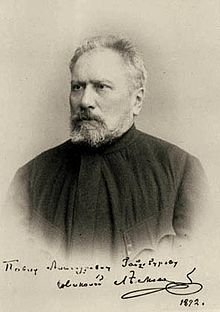The beautiful Asa
The beautiful Asa ( Russian Прекрасная Аза , Prekrasnaja Asa ) is a short story by the Russian writer Nikolai Leskow , which appeared on April 5, 1888 in the St. Petersburg daily Novoje wremja . The author took the material for this early Christian legend from the prologue , the Slavic version of a Synaxarion for the city of Constantinople .
content
Around the middle of the 2nd century AD in Alexandria : The wealthy, but orphaned beautiful young Egyptian Asa inherited a large vineyard on the slope of the Nile from her parents . One evening after bathing in the river, at the last minute, she prevented the suicide of an unknown elderly Greek on her vineyard. Asa lets the life weary tell his story. He is heavily in debt. The creditor demands the young, slender daughter of the debtor as a co-sleeper. Otherwise the debtor will "perish" in prison. Asa goes to a usurer, pledges all of her property and gives it to the immigrant who is a foreign believer. Because of her careless kindness, Asa has to leave the property and make her way through the banks of the Nile .
When Asa tries to drown herself in the Nile, a stranger saves her. This Christian converts the whore . Asa converted.
reception
While contemporary Russian literary criticism took no notice of the text, Leskov received recognition from Goncharov and Tolstoy for the attitude “You are forgiven for your many sins because you showed so much love. But whoever is forgiven little shows little love "
German-language editions
- The beautiful Asa. Translated from the Russian by Karl Nötzel . P. 217–237 in Nikolai Lyesskow: The beautiful Asa. The steel flea. The ready to fight. Three stories. 237 pages. Verlag Karl Alber , Freiburg im Breisgau 1949
Output used:
- The beautiful Asa. Translated from the Russian by Charlotte Kossuth . P. 477–593 in Eberhard Reissner (Ed.): Nikolai Leskow: Collected works in individual volumes. The juggler pamphalon. 616 pages. Rütten & Loening, Berlin 1971 (1st edition)
Web links
- The text
- Entry in the Laboratory of Fantastics (Russian)
- Entries in WorldCat
Individual evidence
- ↑ Russian prologue (book)
- ^ Reissner in the follow-up to the edition used, p. 602, 2nd Zvu and p. 605
- ↑ Edition used, p. 583, 16. Zvo
- ↑ Edition used, p. 586, 11. Zvo
- ↑ New Testament ( Luke 7.47 EU )
- ^ Reissner in the follow-up to the edition used, p. 605, 4th Zvo
